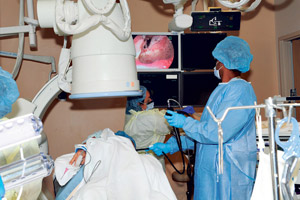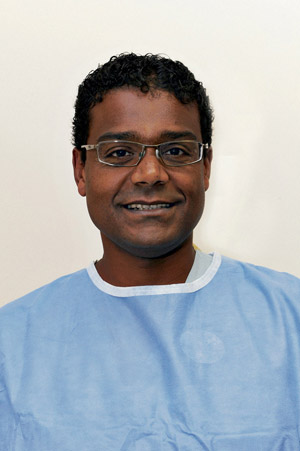Treating Digestive System Diseases
Where did you receive your education and training?I attended medical school at Penn State University, and my internship, residency and fellowship training were at Harvard Medical School. In addition to my position at Pacific Endoscopy Center, I am a gastroenterologist at Pali Momi Medical Center and a professor of medicine at UH JABSOM.
How long have you been in practice?
Since 2000.
What does your role at Pacific Endoscopy Center involve?
I specialize in gastrointestinal procedures – upper and lower. An upper gastrointestinal procedure is typically referred to as an endoscopy. A lower one is referred to as a colonoscopy. The bulk of what we do at Pacific Endoscopy Center is screening for malignancycolon cancer. Colon cancer screening is one of the most common indications for performing a colonoscopy. One of the indications for an upper intestinal test or endoscopy is abdominal pain, suspicion of ulcers, heartburn and suspicion of gastroesophageal reflux disease.
What parts of the body do “upper” and “lower” refer to?
The lower is strictly the large intestines, the colon. Upper is the esophagus, stomach and the beginning of the small intestine.
Are you always looking for cancer, or other health concerns as well?
Other health concerns we diagnose are acid reflux disease, gastrointestinal bleeding, indigestion, nausea, vomiting and diarrhea. That’s the realm of what is required for evaluation by a gastroenterologist involving either an upper or lower diagnostic test. My specific area of expertise is in hepatobiliary and pancreatic disorders. In other words, the liver and pancreas. That’s people who develop conditions such as gallstones, pancreatic tumors, biliary tumors and other pathologies related to the hepatobiliary and pancreatic system.
Who is most at risk for these conditions?
There are many causes. Gallstones, for instance, are a fairly common condition – about 10 percent of the population might have a gallstone at some point. Sometimes it’s hereditary, but also females who are still fertile are more likely to develop stones around the age of 50 than other populations. There also are environmental factors that influence liver and pancreas diseases. With cancer of the pancreas, there’s a whole host of causes. Most relevant are patients who have diabetes, patients who have a history of alcohol abuse, people who smoke. Obesity is also a factor that pancreatic tumors and pathology can be attributed to. Sometimes it can occur without a specific cause or association.

Dr. Yousif A-Rahim (far right) and staff perform an endoscopic procedure on a patient with gastrointestinal bleeding. Nathalie Walker photo
The procedure I perform, among other things, is called ERCP (endoscopic retrograde cholangiopancreatography). It’s a minimally invasive procedure that allows you access to the liver and pancreas without having to do more-invasive surgery. Traditionally, the standard of care in treating these conditions used to be open surgery, whereas with ERCP, it’s minimally invasive because we go through the mouth, a natural orifice, as opposed to cutting into the abdomen. That confers the advantage of having the procedure done and then the patient goes home the same day. A patient who undergoes surgery to have a stone removed or a pancreatic tumor palliated may be in the hospital for days, if not weeks. The quick recovery time is the obvious benefit to this procedure. It’s still considered relatively high risk, but the outcomes are phenomenal, therefore, it has become the intervention of choice for these kinds of diseases.
How does the procedure work?
We use an endoscope and go in through the patient’s mouth. The endoscope is fitted with a camera and it feeds back a live image, usually in high definition. In addition to the endoscope, we use a sort of X-ray called fluoroscopy, which allows you to visualize the inside of the body in real time.
When is an endoscopy recommended?
Very much like a mammogram is recommended at age 40, colonoscopies are recommended at age 50. That is just for people who are asymptotic. If you have symptoms like rectal bleeding, irregular bowels or abdominal pain, nausea, vomiting, you may require that test much sooner. It’s not uncommon for a 20-year-old to get an endoscopy or colonoscopy if the indication is there. We also look for stomach cancers by doing an endoscopy in patients who are high-risk. If you have a direct blood relative who developed, say, cancer in the stomach, we might look in your stomach just to make sure you did not inherit that mutation.
How dangerous is colon cancer?
Colon cancer is the second most-common cause of cancer-related death. The key to preventing cancer is early detection. If somebody developed breast or colon cancer and it’s at an early stage, what we call stage 1 or stage 2 cancer, once you remove that lesion, your life expectancy is essentially unaffected. Other cancers -brain, pancreas, esophagus – people don’t do well only because by the time cancer is diagnosed, the symptoms already have been present for a while. We’re unable to detect those early enough. With colon cancer, when a precancerous lesion called a polyp is detected, it can be removed instantaneously. It generally takes at least seven to 10 years for a simple precancerous polyp to progress to cancer. You remove a polyp at the time of the colonoscopy and you have essentially prevented that lesion from a certitude of becoming a cancer some day.




